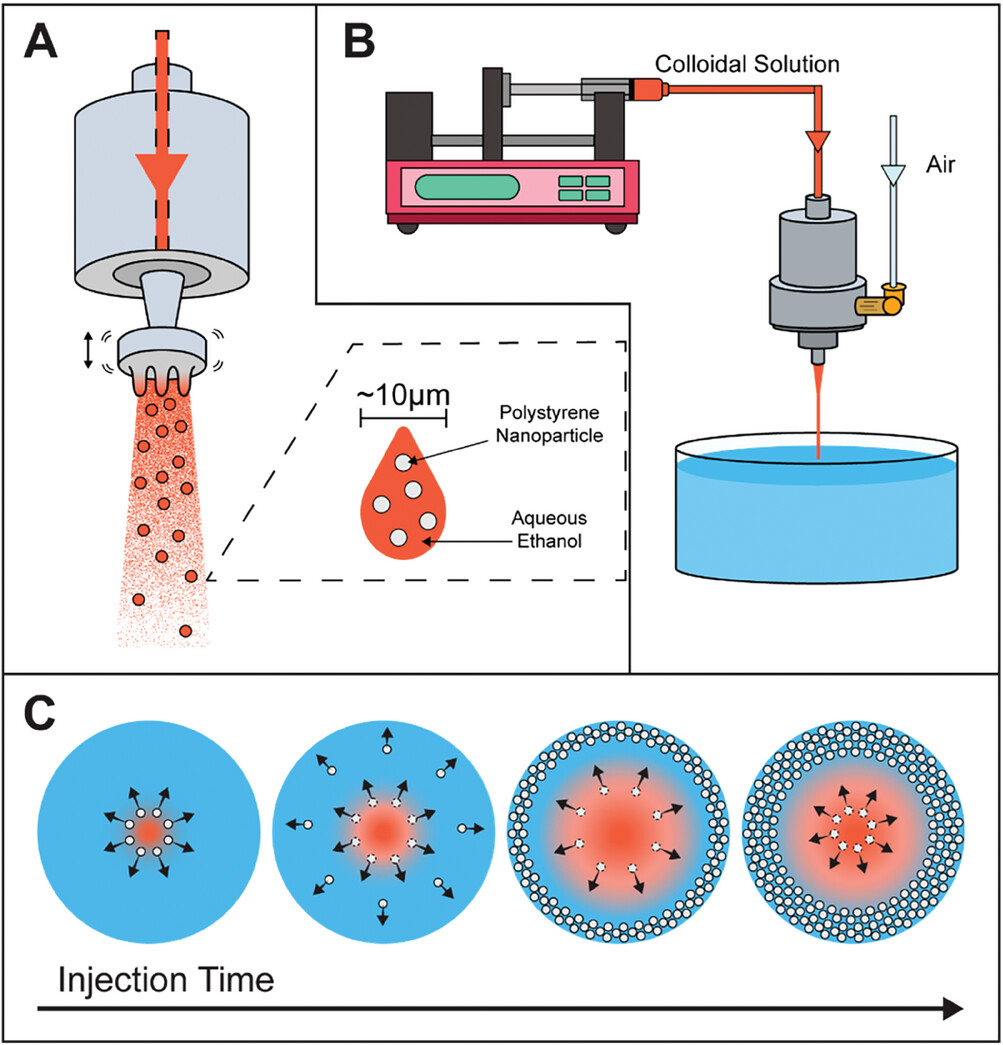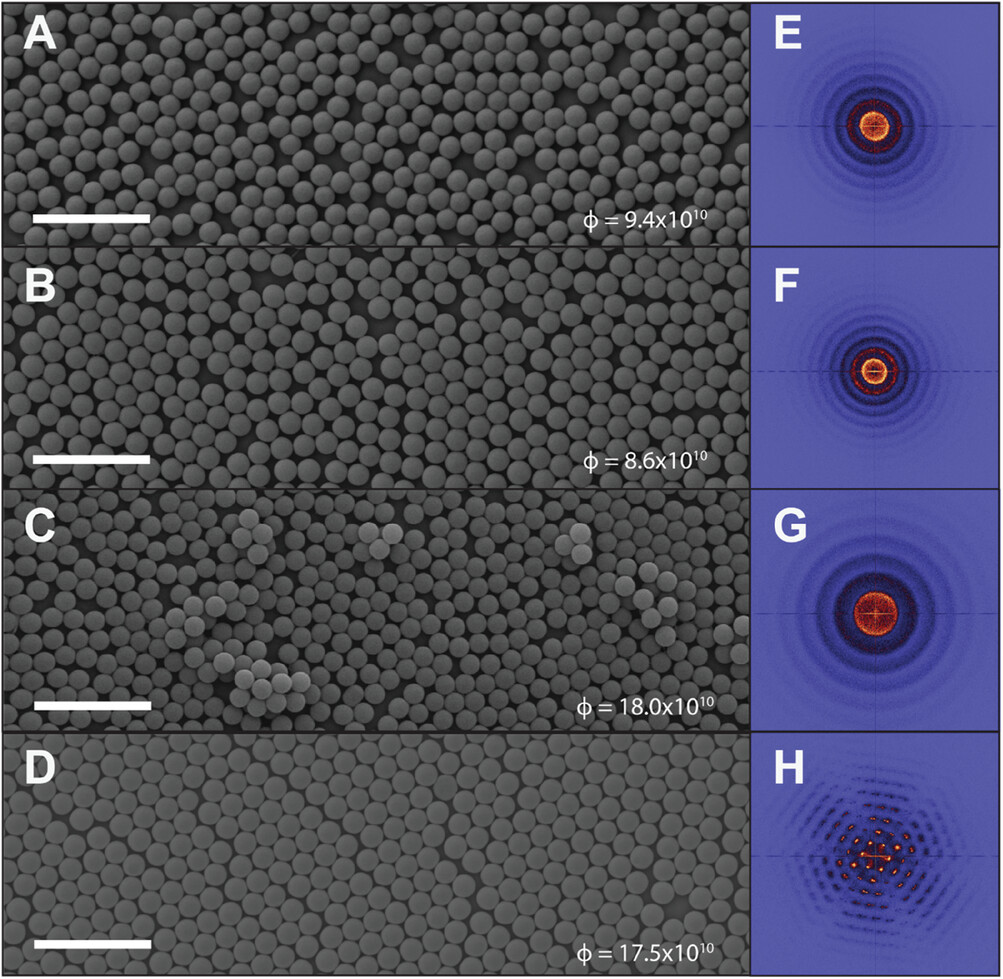| Dec 09, 2023 | |
Extremely rapid aerosol-assembly method enables scalable manufacturing of well-ordered nanoparticle structures |
|
| (Nanowerk Spotlight) Nanotechnology – the manipulation of matter at the atomic and molecular scale – has opened up astonishing possibilities across scientific disciplines. In particular, the bottom-up assembly of nanoscale building blocks promises affordable mass-production of intricate devices with powerful capabilities. However, serious hurdles remain in scaling up laboratory demonstrations into real-world manufacturing processes. | |
| A coveted goal is the rapid, low-cost fabrication of highly uniform coatings made from nanoparticles. By carefully arranging vast numbers of tailored nanoparticles over large surface areas, researchers aim to create sheet-like metasurfaces exhibiting unique mechanical, electronic, and optical properties. Applications span next-generation solar cells, ultra-efficient light-emitting devices, flexible pressure sensors, and visual displays with unnaturally vibrant colors. | |
| Unfortunately, despite promising small-scale demonstrations, enormous challenges have frustrated progress towards scalable nanoparticle assembly. Producing flawless crystalline nanoparticle films over areas stretching square feet to square yards requires extremely complex machines under stringent laboratory conditions. This renders existing methods unsuitable and unaffordable for high-volume manufacturing. | |
| Now, a breakthrough approach from researchers at the University of Texas at Austin demonstrates a transformative alternative. The new directed aerosol-assembly technique demonstrates remarkable throughput and scalability while relying on accessible, inexpensive equipment. By tackling a key production bottleneck, this disruptive advance unlocks the door to commercial nanoparticle technologies that could shape our future in energy, computing, and medicine. | |
| The team published their findings in Advanced Materials ("Massively Scalable Self-Assembly of Nano and Microparticle Monolayers via Aerosol Assisted Deposition"). | |
 |
|
| a) Schematic diagram of aerosolizing nozzle generating micron-scale dispensing droplets carrying submicron colloidal particles. b) Schematic diagram of monolayer self-assembly system. c) Process flow showing self-assembly of submicron colloidal particles self-assembling at an air–water interface as a function of injection time. (Left) Atomized droplets of aqueous alcohol dispensing droplets (orange) impinge on the water’s surface (blue). The alcohol generates a surface tension gradient (orange) which propels submicron colloidal particles (white) radially away from the impact point. Over time continuous injection causes submicron particles to accumulate into an annulus and self-assemble into an ordered monolayer (Right). (Reprinted with permission by Wiley-VCH Verlag) | |
| The new method, dubbed aerosol-assisted self-assembly, leverages an ultrasonic spray nozzle to generate a fine mist containing the nanoparticles suspended in liquid droplets just microns in size. This nanoparticle-laden aerosol is focused into a narrow beam and aimed at the surface of a water bath. When the microdroplets strike the water, the nanoparticles are efficiently transferred to the air-water interface, where they rapidly self-assemble into an ordered monolayer. | |
| The breakthrough lies in using an ultrasonic spray nozzle, which leverages piezoelectric transducers vibrating at 120 kilohertz to generate a fine aerosol mist from the nanoparticle solution. This mist contains discrete liquid droplets just 15-25 microns in diameter. By focusing these droplets into a narrow beam aimed at water's surface, the nanoparticles can be efficiently transferred to the air-water interface when the droplets strike. | |
| The underlying physics involves delicately balancing interfacial tension and dissipating the droplets' kinetic energy to prevent rupturing the water's surface. This prevents nanoparticle loss into the bulk liquid. Meanwhile, surfactant molecules in the aerosol induce strong surface flows along the air-water interface via the Marangoni effect. This helps propel the nanoparticles away from the impact site without aggregation. | |
 |
|
| a–d) Scanning electron microscope (SEM) images of nanoparticle (NP) monolayers self-assembled at low Φ (a,b) and high Φ (c,d) and colloidal solutions with low |𝜁| (a,c) and high |𝜁| (b,d). Fourier transform of self-assembled NP monolayers prepared via Method 2 with |𝜁| = 30 mV (e,g), |𝜁| = 70 mV (f,h). All scale bars shown are 5 μm. (Reprinted with permission by Wiley-VCH Verlag) | |
| A key advantage of this technique is speed. The researchers demonstrated nanoparticle self-assembly rates up to 268 square centimeters per minute—93 times faster than the previous state-of-the-art. Such rapid assembly facilitates the scalable fabrication of nanoparticle sheets across large surface areas. This has been an enduring hurdle for real-world applications of these nanomaterials. | |
| The study provides new insights into the physical factors governing efficient nanoparticle transfer and assembly during the process. Specifically, the researchers found that tailoring the electric charge of the nanoparticles is critical. Nanoparticles with a high electric charge, or zeta potential, self-assemble into highly ordered crystals far more effectively. Such charged particles resist irreversibly sticking together, enabling defects in the growing nanostructure to self-correct over time. | |
| Through careful control of the nanoparticle surface properties and deposition flux, the researchers fabricated exceptionally uniform and defect-free assemblies of nanocrystals over 50 square inches in area. This is a scale relevant for commercial manufacturing. Intriguingly, the technique also successfully assembled more complex nanoparticles, including silicon-titanium core-shell particles with an outer polymer coating. This demonstrates the potential compatibility with a diverse array of nanomaterials. | |
| The nanoparticle sheets retain their structural integrity when transferred to a variety of surfaces, including a curved spherical substrate. This flexibility could enable patterning of next-generation optics or even flexible and wearable devices. To highlight potential applications, the researchers used their technique to fabricate vivid optical coatings exhibiting intense structural coloration. | |
| By offering rapid fabrication, scalability, and broad material flexibility, the new directed aerosol-assembly method provides a pivotal platform for translating a host of lab-based innovations into commercial nanoparticle technologies. The project lead, Professor Edward Yu, noted that their technique is highly modular and leverages equipment already commonplace in industrial manufacturing settings. | |
| The low complexity and high throughput could soon make intricate optical metamaterials, ultra-efficient photovoltaics, and previously inaccessible flexible nanodevices cost-competitive with less sophisticated technologies. This new manufacturing paradigm may help pioneer markets for nanotechnology in emerging economies. With further development, Yu suggests that directed aerosol self-assembly of nanoparticles could complement or even replace existing lithographic methods for nanofabrication, unlocking new opportunities across scientific disciplines. | |
 By
Michael
Berger
– Michael is author of three books by the Royal Society of Chemistry:
Nano-Society: Pushing the Boundaries of Technology,
Nanotechnology: The Future is Tiny, and
Nanoengineering: The Skills and Tools Making Technology Invisible
Copyright ©
Nanowerk LLC
By
Michael
Berger
– Michael is author of three books by the Royal Society of Chemistry:
Nano-Society: Pushing the Boundaries of Technology,
Nanotechnology: The Future is Tiny, and
Nanoengineering: The Skills and Tools Making Technology Invisible
Copyright ©
Nanowerk LLC
|
|
|
Become a Spotlight guest author! Join our large and growing group of guest contributors. Have you just published a scientific paper or have other exciting developments to share with the nanotechnology community? Here is how to publish on nanowerk.com. |
|
